





Florileges is an outdoor fair and festival on Reunion Island in the region of Tampon.
Yes, we are moving from the Jean de Cambiére Park and head towards the town center, which has been turned into a large market. The main street known amongst locals as "rue des 600" or "600 street" as it runs along the 600m elevation level is closed to cars and bikes for the duration of Floriléges. So we can take advantage to leisurely walk around and see what merchants and retailers have to offer. I mentioned the sweet side because I already can smell some goodies cooking here and there. Hope you are hungry and ready for a little extra delicacy!
Hmmm, let see what we have here. A woman offers jars and plastic bags full of yellow-orange powder with a rather aromatic smell. Yes of course, turmeric straight from Plaine des Grégues in Saint-Joseph! Turmeric (Curcuma domestica) originates from India and was brought on Reunion island by the many immigrants who came from the Indian peninsula during the years 1860 to 1890 after the slavery abolition. This plant belongs to the Zingiberaceae family and just like ginger, the useful part is the rhizome which is dried and powdered in order to be used as kitchen ingredient. It gives a fantastic hot yellow color to food and adds a special taste; it also carries many medicinal properties such as bowel cancer inhibitor. It is also used to treat various ailments from cold to liver troubles, vomiting and so on. Now do not be deterred by the fact that many people including growers call the plant "safran" which means "saffron." This is a completely different plant (real saffron is made with stamens of Crocus sativa). Anyway, we are not going to cook right away but we can purchase a small bottle of turmeric syrup, it can be used for pastries, mixed in milk, cocktails or pure to smooth sore throat.
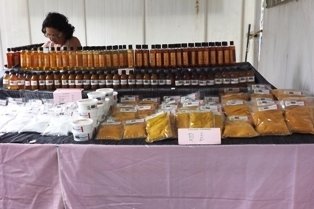
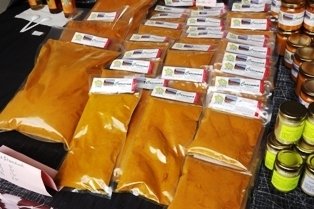
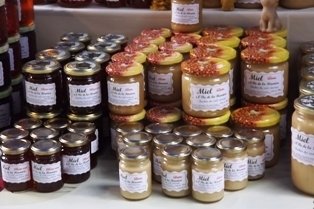 Turmeric for the kitchen?
Turmeric for the kitchen?Next to the turmeric seller we have the honey man! Beekeepers are quite plentiful on the island and many of them move the hives depending on the season so as to offer various kinds of honey. The most common ones are lichee (Litchi sinensis), Brazilian pepper (Schinus terebenthifolius) and mango (Mangifera indica), along with forest honey etc...I suggest that you try the Kahili ginger one (Hedychium sp.) and the 'green honey' which does feature greenish shades and is made by the bees using pollen from an endemic tree (Weimannia tinctoria from the Cunionaceae family).
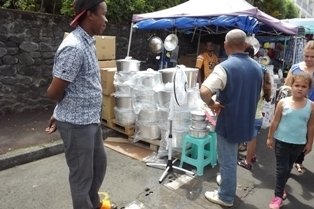
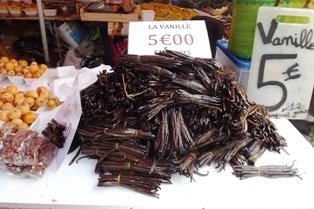
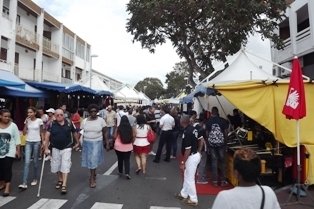 Shiny cooking pots!
Shiny cooking pots!
Vanilla pods ready to go
The 600 Street free of cars
This seller here has piled up a large collection of cooking pots called 'marmites créoles' and used daily for the "cari," "rougail" or "massale," a diversity of stew recipes. They are made of cast-aluminum and are very heavy; they can be used on classical gas cooker or on wood fires which are commonly used on Reunion. Most of those pots are imported from nearby Madagascar where they are made by melting car parts. They are an unavoidable accessory of genuine Creole picnic which never makes use of sandwiches or salads but implies real food i.e. rice, beans and carri! I am not sure such pots would fit into your suitcase...Ah but next to the marmites I can now see what my nose had already spotted, vanilla pods. And yes, those will be much easier and lighter to carry back home and you will be able to use this wonderful spice for some vanilla duck, apple pie, milkshake, rum recipes or just to add an exotic touch to your powdered sugar. Vanilla pod as some of you know, is the ripe fruit of a climbing orchid (Vanilla planifolia) which originates from Mexico and is an important crop on Reunion, mainly in the warm and humid parts of the East and South. It is often grown in natural settings, secondary forests which are carefully partly cleared as some trees are kept to provide both shade and supports needed to grow the plant. As vanilla's natural pollinator (a bee from the Melipone genera) has not been imported together with the orchid, pollination has to be hand-made in the morning while the flowers are mature which means no more than a few hours a day. The grower has to walk through his plants and play the bee role using a lemon tree spine (this is the very traditional way but one can use a large variety of tools to perform the task). The trick is to mimic what bees do: get the pollen and pistils in contact.
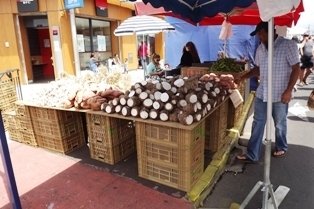
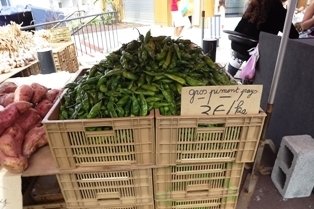
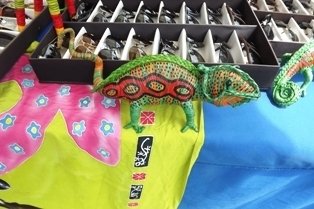
Here we have some basic food ingredients; we may have to purchase one of those cooking pots after all! The ingredients are tubers and hot peppers. More exactly than tubers those are corms from a tropical plant called Colocasia esculenta, a widely grown species which has also escaped in the wild and is found in many streams and rivulets around the island. Leaves are cooked as vegetables (the local 'brédes' as we discussed here, and the corm which acts as reserve organ and is full of starch hence quite nutritious. Right next to those taro corms there is a full box of hot peppers. Do not run for water, those are of the mild sort, not the kind which would set fire to your mouth and stomach. They are called "gros piments" or "big hot peppers" and they can be used like bell peppers - nothing like jalapenos!
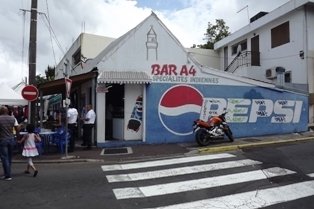
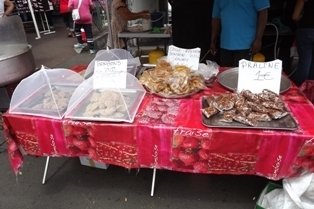
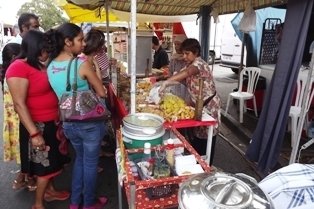 East meets West... Bonbons coco
East meets West... Bonbons cocoJust across the street you can see the 'Bar à 4' which is an Indian-Pakistani restaurant where you can enjoy some genuine oriental food or just sip a tea but let us keep going in the street, I just spotted a really sweet treat for you to try. See those brown things protected by a fine mesh? The panel says "bonbon coco" and yes, you have guessed correctly: coconut sweets are waiting for you. The grated coconut flesh is mixed with granulated sugar and cooked to form a thick and very nutritious mixture, those are colored brown with coffee but sometimes they are made bright pink, green, yellow or orange. Next to them are the more classical and well known sugar almonds. Next door, the Indian woman also sells sweets but I am not sure what those are, maybe some gullam, anyone ready to act as a guinea pig for us? Just look at this funny thing, not a guinea pig but a bright colored chameleon made of straw, definitely some handcraft imported from Madagascar where people are very good at hand work and have a highly aesthetic mind, this would make a nice souvenir to bring back, don't you think ?
I see that you all carry well loaded bags and satchels, so it is probably time to walk back to the car. We can leave all our shopping in the trunk and enjoy some fresh pineapple juice before heading back home. I hope you enjoyed the tour!
Copyright © www.100flowers.win Botanic Garden All Rights Reserved